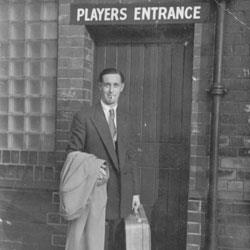George Smith 1921-2013
By Gary James, Wed 17 July 2013 08:53
 The remarkable life of George Smith
The remarkable life of George Smith
Born on 7th February 1921 George Smith's career is a remarkable story of bravery and endeavour. He joined the Blues in 1938 from Salford Adelphi and quickly proved in the A team his worth as an inside-forward but then war broke out and naturally the world changed considerably for all young, fit, agile men.
Inevitably he joined the armed forces but before he left Manchester he did manage to make two first team appearances in the war league. Both games were score draws with Stockport (the first ended 6-6 on 2nd December 1939!).
Then active service took over and Smith went on to serve in Africa. There was nothing unusual about young men serving overseas, however Smith’s life changed significantly when he was under attack from a plane. A bullet entered his right arm above his elbow, travelled down his arm, past his elbow and came out again after travelling a good six or so inches through his arm. Inevitably, Smith was in a great deal of pain, but the most shocking aspect of all of this is that the plane that shot at him was actually from the South African Air Force. This meant that Smith was on the receiving end of what would in the 21st century be described as ‘friendly fire’.
He was lucky the bullet had only entered his arm, but he was desperately unlucky to have been fired at by servicemen fighting on the same side. George spent some time recovering in Africa before being able to return to Manchester.
Why the South African Air Force chose to shoot at him is a mystery and at the time was not investigated. In fact the whole incident was hushed up and George was encouraged not to talk about the specific events. When he eventually returned to Manchester few knew the truth of what happened and, as with so many injured men, it wasn’t a subject openly discussed. Even when the war was over the City football guide for 1945 simply stated: “Smith was one of the first casualties when he suffered a permanent injury to his hand sustained in manoeuvres somewhere in South Africa.”
The permanent injury continued to affect George. Following that terrible incident, George’s hand and fingers were permanently rigid in a clasping fashion, while his arm had two large indentations where the bullet entered and exited his flesh. In addition, the path of the bullet down his arm remained clear.
Despite the injury, George determined to return to football, but even then he found difficulty with the City management. Initially, it was felt his injury may have prevented him from playing. Clearly, his arm would present some difficulties, but as a forward it was his feet and head that provided the main aspect of his play, not his arm, but the City management insisted on George performing a number of trials. He passed them all and on 26th August 1944 he celebrated his return to the first team with a hat-trick against Tranmere in the opening match of the new season. This was first appearance in the first team since 25th April 1942.
By the end of the war George was a key member of City’s side, although he remained a little self-conscious about his arm. Usually he would cover it up with either the sleeve of his shirt, a sock, or a glove, and for team photos and the like the arm was usually hidden either behind his back or carefully positioned behind another player.
Some supporters and reporters thought his arm had been amputated, while others wanted go ask but wouldn’t. Understandably, George wanted his football to do all the talking and when City faced United on 6th April 1946 he netted all four goals as the Blues trounced the Reds 4-1. The match was watched by over 62,000. Scoring four goals - three in seven minutes – made him the undisputed star of the game. George: “I wasn’t much of a drinker… I never went wild or anything… but beating United in that manner and by scoring four goals was a wonderful moment. I enjoyed the day and enjoyed most of the games against them during this period. It was nice for the landlords to put one over the tenants.”
The following season saw the return of League football and George was a key factor behind City’s promotion. George: “The season ended in June and on the last day Roy Clarke made his debut and I scored all five goals when we beat Newport County. It was another great day and I was given the match ball. I’ve still got it because something like that is special, but it didn’t matter so much that I scored five. It was good that we won. I ended the season as top scorer but promotion was the main aim.”
George continued to perform exceptionally well for the Blues over the following seasons. At one point he was on the verge of an England cap, and it is known that he had been mentioned by officials at the FA, however it seems his arm injury may have proved a factor. In the end, to the amazement of most Mancunians, George was not selected for his national side.
In October 1951 he moved on to Chesterfield (scoring 97 in 250 League appearances), and later was player-manager at Mossley and Hyde United. He also managed Prestwich Heys.
Those fans who remember seeing George play remember him with great affection, but all supporters should understand of the difficulties he had to overcome before making his name as a star in City’s immediate post-war period.
Archives